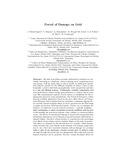| dc.description.abstract | Portal of damage on Grid
(Flórez López, Julio; Hamar, Vanessa; Hoeger, Herbert; Hernández, A.; León Q., Leandro; Núñez, Luis; Ruiz, Nicolás y Uzcátegui, Maylett)
Abstract
The kind of problems currently addressed by scientists are constantly
increasing in complexity, always requiring more computing power
and storage, both for input data as well as results, in addition to specialized
software specific for the different branches of science. There is also
frequently a need to distribute geographically, both computation and data
in a safe and efficient manner. Traditionally, scientific computation had
been performed in centers having supercomputers or clusters, but in many
cases the computational capacity of such centers are insuficient for the requirements
placed by such computations. The Portal of Damage is a finite
element scientific application based on the new called Theory of Concentrated
Damage, that combines fracture mechanics, continuous damage theory
and the concept of plastic hinge. It can be accessed over the Web using
a regular web browser (MS Internet Explorer, Firefox, etc.) to simulate the
behavior of reinforced concrete framed structures { typically buildings {
under earthquakes or others exceptional overloads conditions with the goal
of determining the structural response when collapse or structural failure
occurs. The theory of concentrated damage is based on the assumption that
all inelastic phenomena can be lumped at special locations called plastic or
inelastic hinges. Therefore a frame member is considered as the assemblage
of an elastic beam-column and two inelastic hinges at the ends of member.
This theory is obtained by the introduction of a variable, called damage,
which measures the crack density in the element. The damage ranges from
zero to one, where zero represents elements with no damage (no cracking)
while a value of one represents a totally cracked state. It must be point
out that through the portal only two dimensional (2D) reinforced concrete
framed structures can be analyzed. The first version developed allows for the calculations to be performed on a computational cluster located at
the Universidad de Los Andes National Center for Scientific Computations
(CeCalCULA). Because of the very active fault of Boconó, the Andes
region is a highly seismic zone, thus there is a lot of demand for this application
in the region. This means that the current cluster version of the
Portal of Damage can not adequately fulfill the user's requirements, causing
long job queues, especially during training courses of the tool. Due to
this limitation and the expected heavy use of the portal, rises the need to
migrate the portal so that it can use the computational resources available
on the Grid, given that CeCalCULA is already a partner in some
grid projects, like Grid Venezuela and the EELA-2 project, and for the
EELA project. This allows for the utilization of computational resources
in Venezuelan universities, as well as in Latin America and Europe. This
document describes the experience gained in CeCalCULA through on
going migration of the Portal of Damage application. It describes it's architecture,
gives a brief description of the software, explain in general terms
the run of some preliminary tests sent to the grid, shows the first results
obtained and compares run times. Finally, it describes future plans for
forthcoming tests and the development of the Portal of Damage to three
dimensions (3D) on Grid.
Artículo Presentado en: Proccedings 3 Ibergrid Conference (2008) pp. 124 | es_VE |


